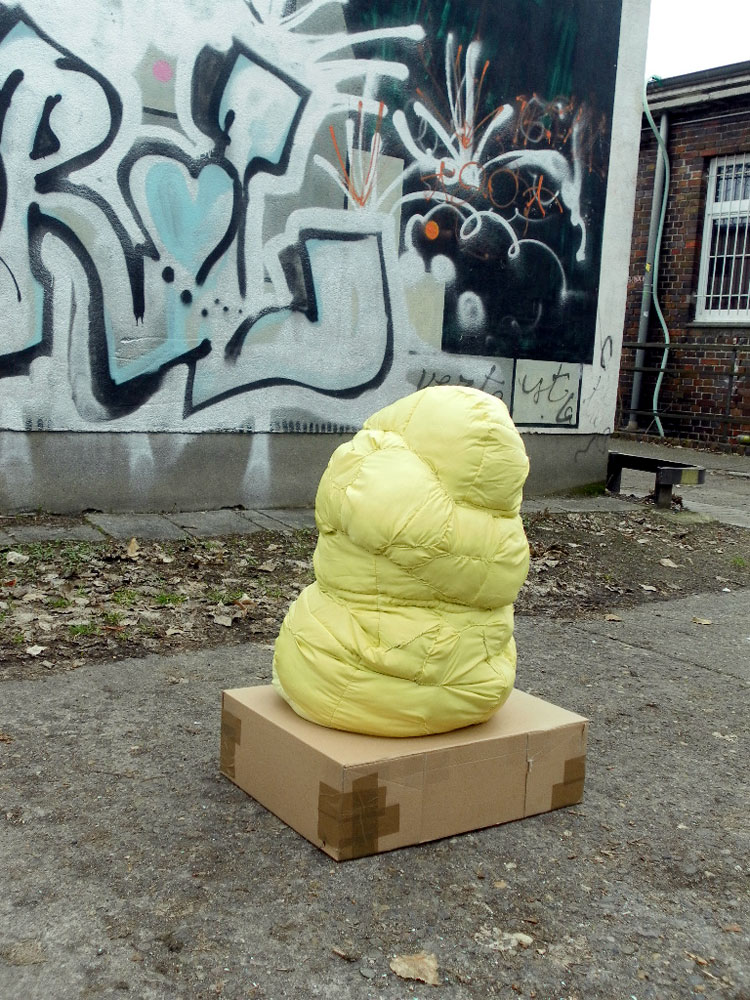Walking Notes and Female Sculpture
What does it mean to walk through the city as a female artist? Is the city different for me? Where do I perceive ruptures and tensions in the city? In the time of the pandemic, the city is quieter and a subtle uncertainty is in the air. I trace this new reality in my walks through Lichtenberg. Through my observations and my walking, a theme formulates itself step by step: the presence and absence of women in the city.
In Lichtenberg there are many statues of women on green spaces: Workers’, mothers’ and girls’ figures that form a decorative female staff between the prefabricated buildings, which was supposed to reflect a part of the city’s population. Despite the idealisation and heroisation emanating from the sculptures, the women’s statues have a certain topicality because women are shown as actors in the city. They occupy the green spaces in between, along which paths lead to the prefabricated buildings. Looking at these places, I can sense a utopia that thought of the city differently, and I wonder if in the time of the pandemic and a time after, these utopian areas of the city will become more relevant. Besides a greener city with more opportunities for walking and being outside, perhaps there would also be a space for a more feminine city? What might this look like?
I seek out the sculptor Emerita Pansowová’s ensemble of figures in the Rathauspark on Frankfurter Allee. Several times the female figure of the sculptural group Heirs of the Spartacus Fighters (1987) has been knocked over, broken and renovated. The puttied areas resemble seams running through her stone body. Someone has spray-painted an elongated stain with green paint between the sculpture’s legs. It could be a phallic symbol. The uncertainty and a growing doubt triggered by the graffiti suddenly make the female figure seem ambivalent. The next day I go to the shore of Rummelsburg Bay. I notice paper cranes tied to a construction fence and trees. I read on a piece of paper that a femicide had taken place here. The murdered woman wanted to distribute one thousand paper cranes in Berlin. I walk further along the riverbank to the new residential district of Berlin Campus, where the Rummelsberg asylum was located in the 19th century. From the imperial era, the Weimar Republic, the Nazi era to the GDR, prostitutes, homeless people, homosexuals, later also Sinti and Roma and regime critics were housed, imprisoned and interrogated for resocialisation in this building complex. Steles with texts and photographs of the people remind us of their stories. In some photographs, women’s faces are blurred. Concealing them makes their vulnerability, the fragile status of their lives and the inescapability of the state power they were subjected to more obvious. These women are connected to the place even though their traces have dissolved. There is no graffiti or other random traces here. Even the establishment of women’s names as street names in this neighbourhood does not fall on a living, historical foundation, but on a strange emptiness. Is this where the city ends?
In boxes placed on the street in the Victoriastadt neighbourhood lie articles of clothing. I take a fitted faux fur jacket because it reminds me of the colour and structure of the stone in Emerita Pansowová’s sculpture. One day I walk through the area of the BLO studios and discover a demolished sculpture. A female nude with missing arm and foot, on which dark green lichen is spreading. In the background, Lichtenberg’s prefabricated buildings can be seen behind wintry branches. This urban situation resembles a stage that has no audience: A wasteland between railway tracks, garages and willow trees, where wood piles and metal scraps gather. In my memory, Édouard Manet’s figure subject from Le Déjeuner sur l’herbe (1867) emerges. And I think about the kinship between the naked woman in Monet’s painting and the sculpture on the studio grounds: About the obvious exposure of the female figures to their surroundings. The woman in Monet’s painting was the painter Victorine Meurent. Monet painted her, for example, as a street singer, Olympia and The Lady with the Parrot, who wears a long yellow dress in the painting. After Victorine stopped modelling for Monet, she became impoverished and walked the streets of Paris as a beggar woman, with a small monkey on her arm, collecting money.
Because these female bodies that I perceive on my walks through Lichtenbergs have been attacked and deformed, an image idea for a temporary urban sculpture is slowly forming in me. A sculpture made of fabric, cloud-like, but resistant to external circumstances. Similar to a dummy that, after external shocks, loses its shape. My Female Sculpture is an amorphous yellow-green bundle of fabric, a thought – an unfinished manifesto.
*** Translated with www.DeepL.com/Translator (free version) ***



